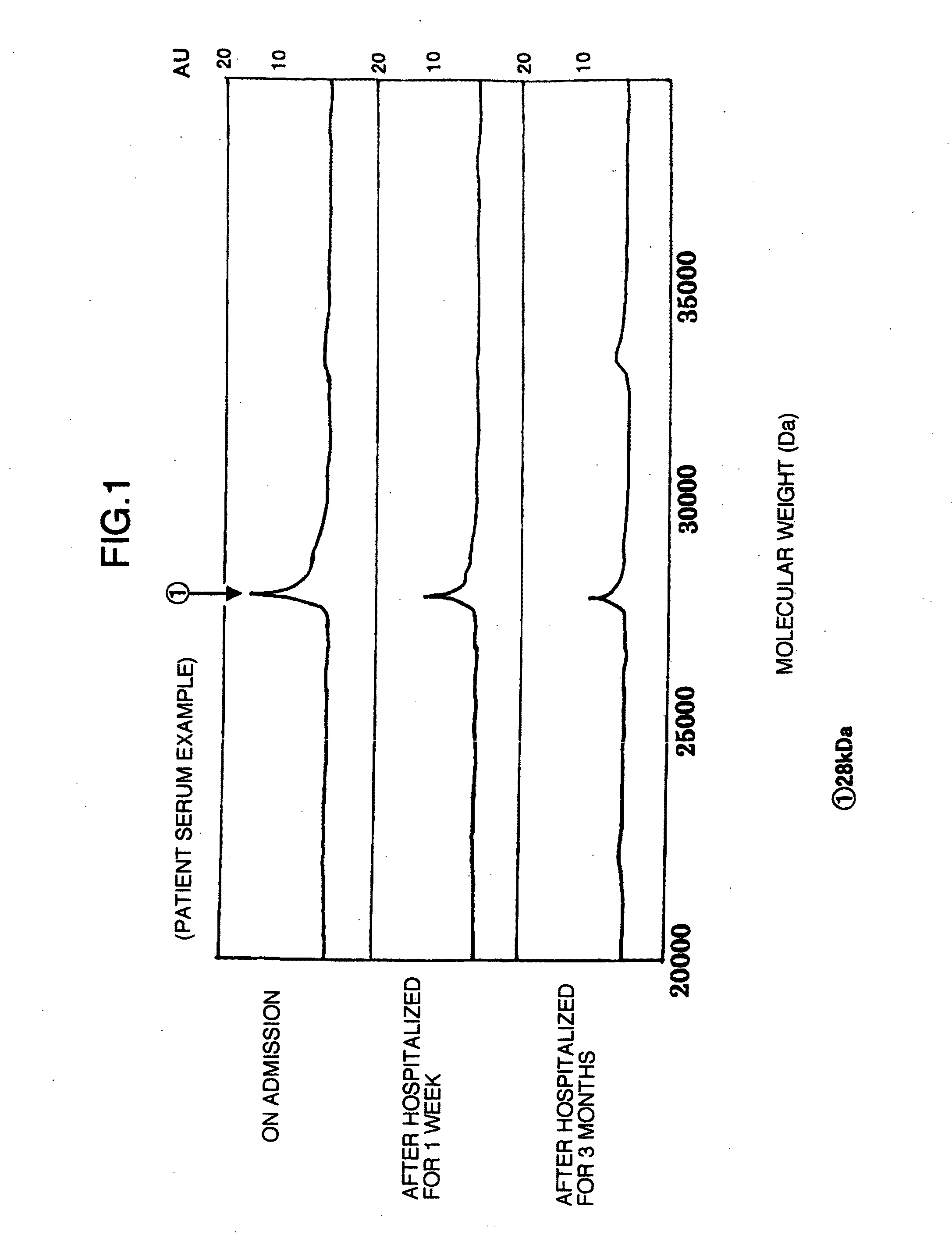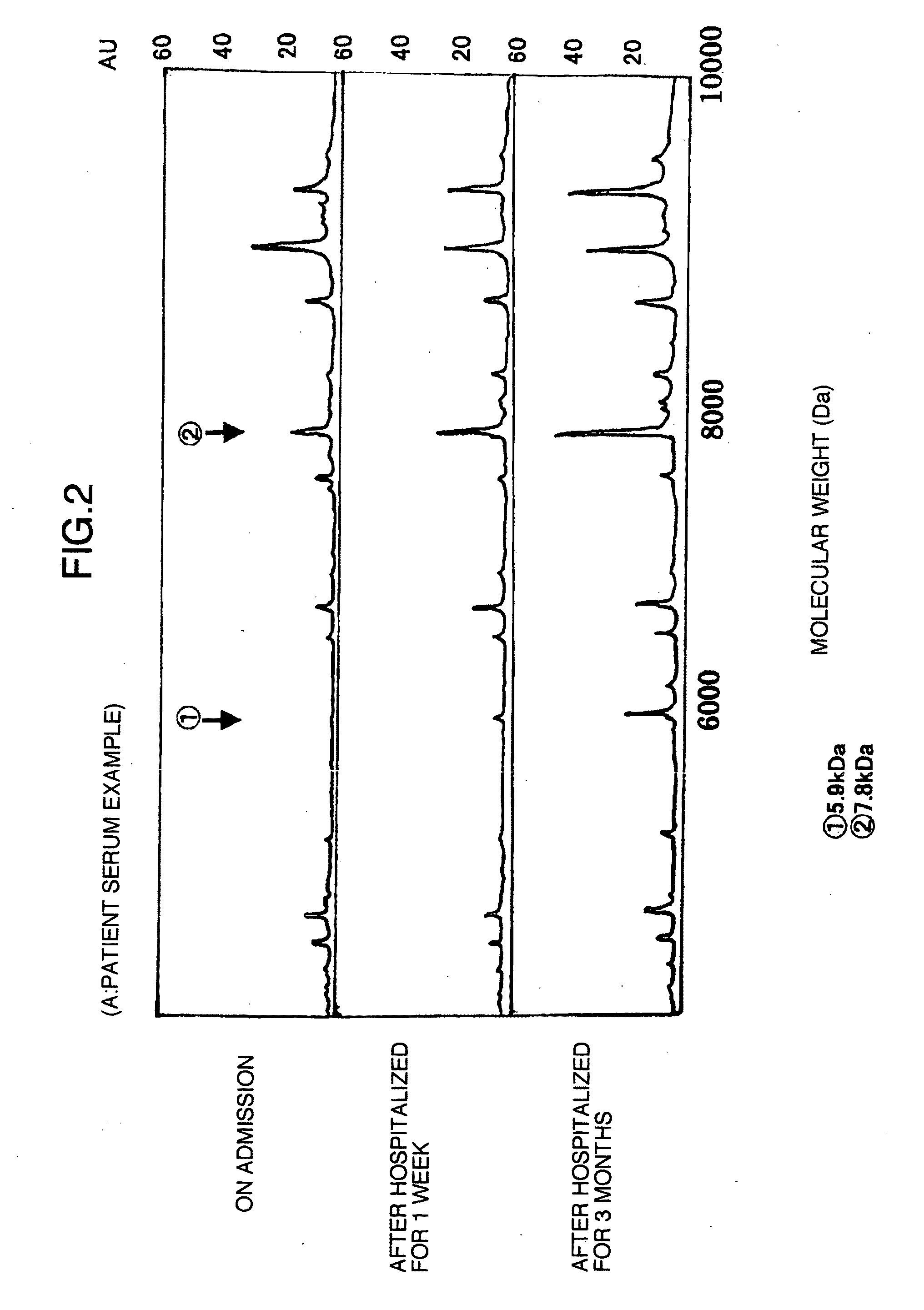Marker proteins for diagnosing liver disease and method of diagnosing liver disease using the same
a technology of liver disease and marker proteins, applied in the direction of peptide/protein ingredients, instruments, fibrinogens, etc., can solve the problems of inability to put adduct to practical use, disadvantageous method for detection of low-molecular weight proteins or peptides, etc., and achieve the effect of early and accurate screening
- Summary
- Abstract
- Description
- Claims
- Application Information
AI Technical Summary
Benefits of technology
Problems solved by technology
Method used
Image
Examples
example 1
Identification of a Marker Protein for Diagnosing Liver Disease by the Use of SAXII Protein Chip Arrays
[0047]Using the sera of patients from whom informed consent had been obtained, a novel marker for liver trouble in the sera was searched for by the use of SAXII protein chip arrays (Ciphergen Biosystems, Inc.). The SAXII chip refers to a strong anion exchange chip and is characterized in that it binds thereto a negatively charged substance in a sample. The sera of the patients with alcoholic liver trouble immediately after admission, those 1 week after abstinence and those 3 months after abstinence and the sera of normal persons were used as samples.
(1) Method
[0048]A method for experimental operation of the protein chip array is briefly described below. Each serum sample was diluted 10-fold with a 8M urea (SIGMA) / 1% CHAPS (SIGMA) solution. After on-ice treatment for 10 minutes, the serum sample was further diluted 10-fold with 50 mM Tris (SIGMA) buffer (pH 9.0) and centrifuged at 4...
example 2
Identification of Marker Proteins for Diagnosing Liver Disease by the Use of WCXII Protein Chip Arrays
[0051]Next, using exactly the same samples as in Example 1, novel markers for liver trouble in the sera were searched for by the use of WCXII protein chip arrays (Ciphergen Biosystems, Inc.). The WCXII chip refers to a weak cation exchange chip and is characterized in that it binds thereto a positively charged substance in a sample.
(1) Method
[0052]A method for experimental operation of the protein chip array is briefly described below and is substantially the same as in Example 1. Each serum sample was diluted 10-fold with a 8M urea (SIGMA) / 1% CHAPS (SIGMA) solution. After on-ice treatment for 10 minutes, the serum sample was further diluted 10-fold with 50 mM sodium acetate (SIGMA) buffer (pH 6.5) and centrifuged at 4,000 rpm for 5 minutes, and the supernatant was used as a diluted sample. An experiment was carried out by attaching the WCXII chip to a bioprocessor. At first, 150 μL...
example 3
Identification of the 28 kDa Protein
[0054](1) The 28 kDa protein found by the SAXII protein chip experiment was purified from a serum sample with FPLC Pharmacia LKB (Amersham Pharmacia Biotech AB) by the use of a HiTrap Q column under the following conditions: 50 mM Tris buffer (pH 9.0) and a flow rate of 2 ml / min. Thus, the 28 kDa protein of interest could be purified as a substantially single fraction. This fraction was confirmed as follows by electrophoresis. The fraction was mixed with 2× sample buffer (0.25 M Tris-HCl (pH 6.8), 4% SDS, 20% glycerol, 0.01% BPB and 10% β-mercaptoethanol) in the ratio of 1:1 and treated at 90° C. for 2 minutes. The fraction thus treated was used in the electrophoresis. The electrophoresis was carried out at 10 mA by the use of 15 to 25% polyacrylamide gradient gel (Perfect NT Gel System Products).
[0055](2) As shown in each of the lanes 4 and 5 in FIG. 4, a band was confirmed at a position corresponding to 28 kDa, by Coomassie Brilliant Blue staini...
PUM
 Login to View More
Login to View More Abstract
Description
Claims
Application Information
 Login to View More
Login to View More - R&D
- Intellectual Property
- Life Sciences
- Materials
- Tech Scout
- Unparalleled Data Quality
- Higher Quality Content
- 60% Fewer Hallucinations
Browse by: Latest US Patents, China's latest patents, Technical Efficacy Thesaurus, Application Domain, Technology Topic, Popular Technical Reports.
© 2025 PatSnap. All rights reserved.Legal|Privacy policy|Modern Slavery Act Transparency Statement|Sitemap|About US| Contact US: help@patsnap.com



